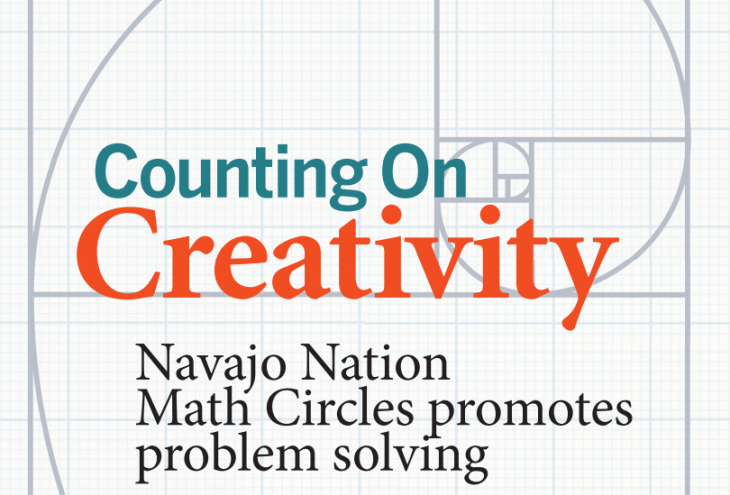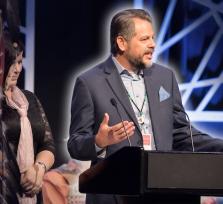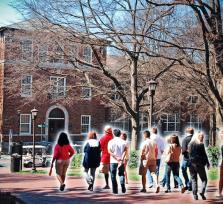In the high desert around the capital city of Window Rock on the Navajo Nation, you will find a scene that has been common in Eastern Europe since the 1930s. Schoolchildren are gathered with heads bowed and pencils clutched, intently looking at math problems. They may be serious about the task at hand, but they also laugh, discuss, and debate a little before one steps to the board and lays out a problem — and an equation to solve it — in an exercise that demonstrates both technique and skill. The technique is called Math Circles, and it emphasizes the journey to a solution over memorizing textbook formulas. Math Circles offers a creative way of learning in a group — one of the goals of the Navajo Nation Math Circles Project (NNMCP). Another goal is attracting more Native Americans to STEM fields. NNMCP offers after-school programs, teacher development, and a two-week summer program. Those programs are codirected by Henry Fowler from Diné College, Tatiana Shubin from San Jose State University, and David Auckly from Kansas State University.
TOWARD INNOVATIVE TEACHING
While European students have been learning math in this program for decades, American educators have begun to embrace Math Circles in only the past 12 years, according to the American Mathematical Society website. The NNMCP program is just one of the more than 180 different Math Circles programs across the country, each promoting problem solving with its own unique approach, focus, pedagogy, and goals. “Some versions of the program are very academic, working to compete in local, regional, national, and international math competitions,” says Duane Yazzie, a PE teacher at Tsehootsooi Dine Bi’Olta and the originator and facilitator of a Math Circle at Tsehootsooi Intermediate Learning Center. “Others are more recreational and exist purely for the enjoyment of being with people who share a love for math.” Fowler, who started NNMCP in 2012, grew up on the western edge of the Navajo Nation surrounded by indigenous knowledge of math. Everywhere he looked as a young boy, he saw numbers, patterns, and story problems. When he was sent outside to help herd his family’s sheep, he learned how to skip count, naturally. “My mother would ask me to count,” he recalls. “I had a special way I could group them. Back then we had more than 200 sheep. In the corral I would group them in a different way, ‘This group is 18, this group is 25, this group is 29, etc.’” Inside the family home he would watch his mother weave rugs with intricate geometric designs. She would pull pieces of yarn forward to create the pattern in a seamless flow of fingers, never consulting a chart or graph to see if she was following directions. “Math has always been my nature since I was a child,” says Fowler. “It’s integrated into our Navajo culture.” He played chess in high school and continued to have an interest in math. He joined AISES as a college student and was encouraged by its programs. Fowler earned a BS in math education from Northern Arizona University and an EdD from Fielding Graduate University in Santa Barbara, Calif. When he reported to his first teaching job at Red Mesa High School in Arizona, he found that something was missing. “There was no math textbook,” he laughs. That was actually fi ne with Fowler because it meant he could create his own culturally relevant Navajo math lessons. From Red Mesa he went on to teach at Ganado and Chinle High Schools. As a teacher he introduced his students to AISES by bringing them to the National Conference. In 2011 he started working at Diné College. “Tribal leaders always discussed infrastructure, nation building, and unemployment, but there’s one thing they leave out,” he says. “Any nation that wants to build autonomy must have a very strong math education K–12. Math is basic for a sovereign nation. Mathematics makes us international leaders.” The leader of the free world agrees. Last August President Barack Obama gave 213 teachers a Presidential Award for Excellence in Mathematics and Science Teaching as part of his Educate to Innovate campaign, which includes a plan to hire 100,000 STEM teachers by the year 2021. “These excellent teachers are preparing students from all corners of the country with the science, technology, engineering, and mathematics skills that help keep us on the cutting edge,” the president noted. In addition, the president’s Master Teacher Corps initiative is looking to identify effective STEM teachers who can share their methods. Sometimes the best method, according to Fowler, is for teachers to get out of the students’ way. “The students are the ones who are engaged,” he says. “They’re the ones who are driving the problem solving. The teacher is just a facilitator.” Fowler encourages and motivates students and asks appropriate questions to guide them. In the end they may not get the right answer, he says, but that’s OK. “As long as you give the student the right resources, as long as they are interacting with a math concept, let their curiosity thrive, drive, and come to a conclusion,” he explains. “Let them argue their point of view. That’s the way they develop an understanding of math concepts.”
FILMING BY THE NUMBERS
Math has long been a fascination for George Csicsery. A producer of several math-related documentaries, he learned of the Math Circles program on the Navajo Nation through a mathematician named Jon Buhler and decided not to believe the naysayers who warned that the Navajo people wouldn’t open up to an outsider. To supplement the partial funding commitment he already had from the Mathematical Sciences Research Institute, he applied for a grant from Vision Maker Media, which works primarily with Native producers to tell stories from Indian Country in partnership with public broadcasting. Csicsery’s proposal was just one of anywhere between 40 and 75 applicants yearly hoping to get funding — and his was accepted. “We’re always looking for unheard-of stories,” says Shirley Sneve, the executive director. “The STEM aspect was interesting.” The panel of judges agreed and gave Csicsery a grant. Sneve says she had never heard of Math Circles. “These people are excited about math! Who does that?” she laughs. With his crew from Zala Films, Csicsery focused on Fowler, Shubin, and Auckly, as well as several other teachers. After 18 months of production he released his documentary, Navajo Math Circles, at the start of 2016. “Mathematics, like religion, is about looking for truths,” says Csicsery. “The difference is that once something in mathematics is proven to be true, there is no more doubt; everyone agrees. In a world where almost everything else is the basis for disagreements, this is pretty reassuring.” The great surprise for Csicsery was how deeply individuals opened up to him. “I went into the project with stories about how hard it is to gain trust among people on the reservation,” he recalls. “I experienced the opposite.” Csicsery says he was also greatly surprised at the friendships he formed during the process. He even traveled with some students to Seattle, where the documentary premiered. “I never expected that type of bonding. I have new Navajo friends all over the reservation,” he says. Csicsery interviewed Natanii Yazzie, who told him, “It’s the process that makes you enjoy math.” He also interviewed Charmayne Seaton, who admitted she didn’t like living on the reservation when she was a little girl, but she’s changed her mind and credits Fowler and his math lessons. “Like Henry says, ‘You never run away from a problem, you always face it in the eye.’” Csicsery says that type of attitude, which he profi led in his documentary, helped him produce this story. “It might also have to do with the fact that the fi lm shows Navajo youth in a largely positive light, while so many other documentaries are catalogs of woe and misfortune,” he adds. Sneve agrees. “The parents in particular were really happy to share something that made a difference in their children’s lives,” she says. The film also shows the students’ perspective of living in a place where a 30- to 40-mile one-way trip to school is considered close. Csicsery believes both Fowler and Shubin are exceptional people whose stories need to be told. He was also taken with the Navajo culture. “Several of the students and parents communicated things about the rhythms of life that the outside world rarely encounters,” he says. “My hope is that audiences seeing Navajo Math Circles can slow down and savor this style of looking deeper. If the film can teach people to value concentration while seeking beauty, what more could I ask for?” Navajo Math Circles will be shown at the 2016 AISES National Conference, which will be the first time Sneve sees it with an audience. She’s looking forward to that experience because she says this documentary combats a lot of negative stereotypes about Native Americans. “This one blows them out of the water,” she says. “It shows that Native Americans care about their families, their children, their education. It dispels a lot of the stereotypes we have for people in poverty.”
EXPLORING MATH TOGETHER
That care is shown in how the program is set up. “The students gather in a family-like setting to work on and explore mathematics in a nonthreatening manner,” says Duane Yazzie, who was also interviewed in the documentary. “Math Circles is successful because they engage everyone in some way that keeps them thirsting for more.” Yazzie says that interest is so great that students look forward to signing up for Baa Hozho, the two-week-long summer math camp at Diné College. He is also helping Fowler bring Math Circles to more Native American reservation schools. “We help them learn about the concept of perseverance,” Yazzie adds. The program’s success brings to mind the saying “it takes a village,” which Fowler is experiencing firsthand. “When I came to Diné College students went only as far as Math 110,” he recalls. “They never went to pre-calculus or calculus 2 and 3. I wanted to face those challenges.” That’s what prompted Fowler to start a summer math camp. The first year he had 30 students, and then it took off. “It led to professional development for teachers K–12,” he says. “Then it went to after school. It led to bringing in mathematicians to work with students.” Now every April he hosts a math festival. Thanks to interest from the students, he’s also been able to introduce calculus 1, 2, and 3 to Diné College, plus a course in differential equations. His “village” includes people like Yazzie and other math-loving teachers. “I’m getting a lot of support. When I go to the school site, I always bring a mathematician,” Fowler says. “They help me with Math Circles. They have a different way of conveying math — they let the students know math is not driven by textbooks but by open-ended questions.”













